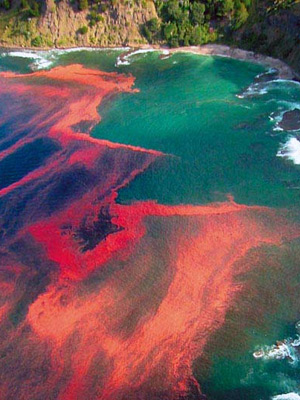Daily Newsletter March 27, 2012
Today's Topic: Harmful Algal Blooms
Algae inhabit many areas of the world. There are marine and freshwater algae, soil algae, and those that form symbiotic relationships to produce lichens. All algae have photosynthetic capabilities, which means that they are primary producers (first level of a food chain), and are oxygenic (produce oxygen).
There are secondary metabolites that algae can produce, for example the Rhodophyta (Red Algae) produce Agar. This gelatinous substance is used for microbiological media, and in cooking. As a culinary agent, it is used as a substitute for pectin to produce jellies, jello, and other gelatinous confections. It is also used as a gelling agent in ice cream. (What is the chemical structure(s) of Agar?)
Not all phytoplankton secondary metabolites are so useful or desirable. Some algae produce toxins, most often neurotoxins. At low concentration levels, they are of minimal risk. The problem is that they can bioaccumulate in marine organisms, most notably shellfish.
- The diatom Nitzschia navis-varingica produces the toxin domoic acid, which in high doses, causes permanent loss of short term memory and brain damage. Death is a possible outcome with high concentrations of the toxin.
- The dinoflagellate Alexandrium fundyense produces saxitoxin, the toxin responsible for paralytic shellfish poisoning (PSP). PSP has multiple symptoms, that usually start with abdominal cramps and diarrhea, but progress to mental functions and loss of coordination. As the name implies, paralysis is an advanced symptom.
- Karenia brevis, a dionflagellat, produces brevetoxin, which causes neurotoxic shellfish poisoning (NSP). NSP has no reported fatalities, unlike the previous two toxin based diseases, but can cause painful abdominal problems, slurred speech, and other neurological problems.
Daily Challenge: Pick one of the harmful algal blooms above and discuss it in more detail. Describe the algae and it's habitat. When and why would the algae experience a bloom? Describe the toxin, and the affect it has on human phisiology. Why doesn't the toxin affect shell fish? Describe the signs and symptoms of the disease condition (signs are observable, while symptoms are personal to the patient; e.g., patient core temperature or blood pressure is a sign, nausea or a feeling of unease is a symptom).

No comments:
Post a Comment